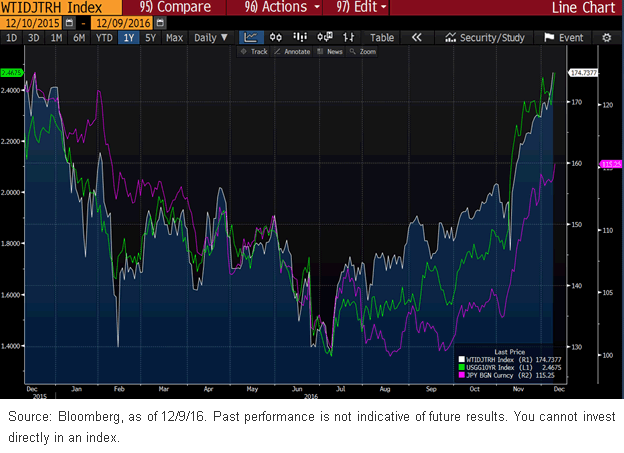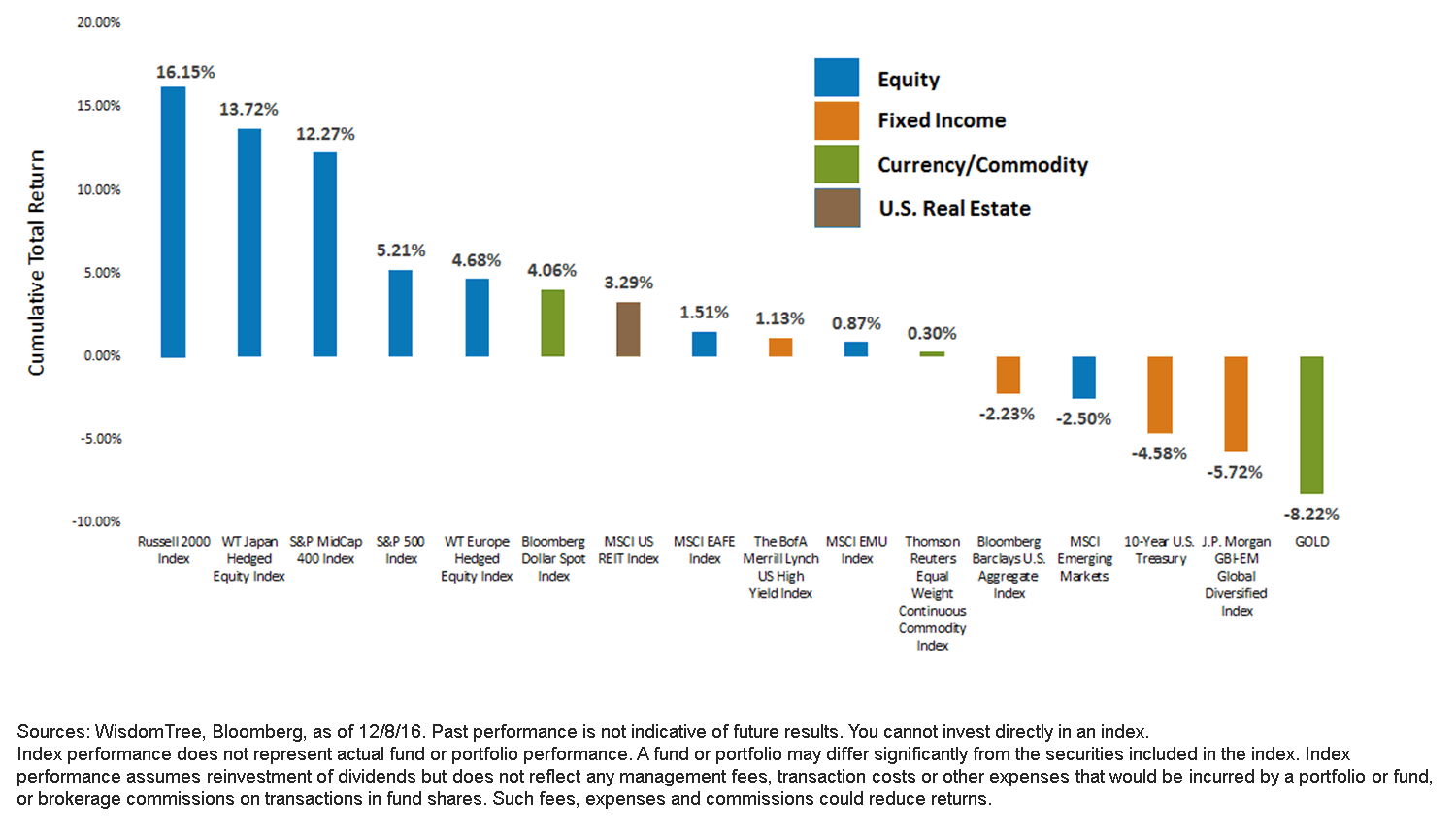The Fed Hikes Rates: What's Next For Stocks?
The Federal Reserve’s (Fed) decision to raise its policy rate for the first time in a year has been baked into the market for some time. Questions for 2017 will be, how fast does the Fed raise rates from here, and at what point do investors need to begin worrying about the Fed inverting the yield curve? My best guess is that will not be a concern in 2017, as expectations for faster gross domestic product (GDP) growth and a pickup in inflation are likely to keep longer-dated rates higher than they have been for the past few years. This, I believe, will continue to create a benign environment for stocks to levitate higher.
Three of my favorite equity asset classes for the year ahead continue to be Japan and U.S. small and mid-caps.
Impact on Equities and the Dollar
With the election of Donald Trump, 10-year and 30-year interest rates have continued to back up in the U.S., accelerating sector rotation shifts in the S&P 500 Index. From November 8 to December 9, Financials and Consumer Discretionary stocks have outperformed the market, while Utilities and Consumer Staples underperformed the S&P 500—reversing the 10-month trend in place before the election. As the market resets and adjusts to higher rates, Financials may continue to show relative strength in the rising interest rate environment.
Overseas, we have seen the U.S. dollar, as measured by the Bloomberg Dollar Total Return Index, rally 4% since the election. I expect this recent dollar strength will continue, given that interest rate differentials and recent price momentum favor the dollar versus many major developed world currencies.
We believe the yen, which rallied 16% year-to-date through the first three quarters, did so in part because expectations for Fed rate hikes were lowered in the first six weeks of this year. That has changed dramatically since the election, as prospects for future inflation and future GDP growth have picked up with the election of Trump. The yen has weakened as U.S. rates and the U.S. dollar have risen. This is providing a tailwind for Japanese stocks and for the earnings expectations for Japanese multinationals and Japanese banks in 2017. If one were neutralizing the currency, Japanese stocks have been one of the best performing asset classes since Trump’s victory—up more than 13%. Given the current differential in interest rates, we believe investors wishing to gain exposure to the Japanese or even European equity markets should consider doing so in a currency-hedged fashion.
As shown in the chart below, the Japanese yen has been extraordinarily sensitive to the direction of 10-Year U.S. Treasury yields. As yields have headed higher (green), the yen (magenta) has weakened, depreciating from 100 to 115 compared to the dollar. And as rates have risen and the yen has weakened, the WisdomTree Japan Hedged Equity Index has moved in lock step with rising U.S. interest rates. Although the Index is roughly flat for the year, it is up 37% since interest rates bottomed July 8. In fact, the WisdomTree Japan Hedged Equity Index is up more than any of the sectors of the S&P 500 over that period.(Visit the WisdomTree Japan Hedged Equity Index page for standardized performance.)
Here in the U.S., mid- and small-cap stocks have led the market rally since November 8 and have outperformed most of the major asset classes as shown below. Given the large outperformance of mid- and small-cap companies, is this an area of the market that investors should continue to focus on in 2017? I believe it is, if one can manage for the valuation risk of buying into these asset classes after 2016's large run-up.
One of the ways to do this is by using exchange-traded funds (ETFs) whose underlying indexes rebalance equity markets back to a measure of relative value. WisdomTree does this in both its dividend-weighted and earnings-weighted Indexes.
For example, when WisdomTree rebalances the WisdomTree SmallCap Earnings Index and the WisdomTree MidCap Earnings Index each December, the price to earnings (P/E) (both trailing and forward) ratio for the Indexes is typically lowered relative to where it was before the rebalance and relative to comparable cap-weighted Indexes. That means those who invest in their tracking ETFs, the WisdomTree SmallCap Earnings Fund (EES) and the WisdomTree MidCap Earnings Fund (EZM), may have an opportunity to buy into the small- and mid-cap space at a more reasonable market multiple while still gaining broad exposure to the asset class. Moreover, because both Indexes include only profitable companies at the annual rebalance and weight components based on the earnings they’ve generated, the two WisdomTree ETFs tracking these Indexes may benefit from cuts in corporate tax rates more than other small-cap indexes that include a greater percentage of unprofitable companies. For example, around 20% of the weight of the Russell 2000 Index is typically in companies that generate no profits.
Cumulative Total Return Since Presidential Election
November 8—December 8
(Click on image to enlarge)
Conclusion
With the investment landscape looking very different from a year ago, it may be time for investors to shift portfolios and rebalance accordingly. I believe key differentiators for this decision-making process are rising interest rates, GDP growth expectations and domestic tax cut expectations, meaning, in my view, potentially tilting toward Japanese hedged equities and U.S. small and mid-caps. For Japanese hedged equities, WisdomTree offers the WisdomTree Japan Hedged Equity Fund (DXJ).1 And for U.S. small and mid-caps, fresh off an earnings weighted rebalance that becomes effective December 19, WisdomTree offers the WisdomTree SmallCap Earnings Fund (EES) and the WisdomTree MidCap Earnings Fund (EZM).
more
Comments
 No Thumbs up yet!
No Thumbs up yet!





